Destinations
Saturday, April 18, 2020
Monday, August 22, 2016
Inside Russia:St. Petersburg
On June 22 our Ship touched the St. Petersburg's (Russia) harbour. Russia has always been a fascinating place, mysterious, far away from the Western world of democracy and liberalism.In a Catholic School we were asked to write an Essay "Which country I would like to visit" By copy Paste from the Reader's Digest I wrote about Russia and I got the citation for the best essay, an unusual thing in a Catholic school. I had no fascination for Russia but there was an inner desire to see what is there in this country which once was so powerful.
St. Petersburg is the most westernised city of Russia as well as its cultural capital. Some of the monuments here constitute the UNESCO heritage sites. Peter the Great was interested in seafaring and maritime affairs and intended to give Russia a seaport in order to trade with maritime nations.He had a port called Arkhangelsk which was on the white sea and inaccessible to ship during the long winter months. On May, 12, 1703, Peter the Great captured the Port of Nysenkans. He later built the Peter and Paul fortress which became the first brick and stone building of the new city.
The City was built by conscripted peasants from all over Russia besides swedish prisoner of wars, many of whom died in the harsh weather and other difficulties.
After crossing the Neva River and other historic sites, the Coach took us to the town of Tsarskoye Selo, more commonly known as Pushkin which is 30 kms south of St. Petersburg.Catherine I of Russia hired a German architect to construct a summer palace for her.In 1733 it was expanded with a much granded edifice in a flamboyant Rococo style. More than 100 kgs of gold were used to gild the sophisticated stucco facade and numerous statues erected on the roof.
Later Catherine the Great who had a passion for antique and Neoclassical art, employed a Scottish architect who refurbished the interiors in the Neo Palladian style which was in vogue then. Just before entering this Palace is the statue of Pushkin(1799-1837) considered to be one of the greatest Poets/playwright of Russia.He was killed in a duel at a very young age.
The Catherine Palace is one of the design of Russian baroque,with decorated amber panels backed with gold leaf and mirrors. There were several renovations to the Palace adding glory to its size and beauty.The stroll outside gives an idea of the Russian concept of gardening and converting nature into a beautiful masterpiece.
The Grand Cascade(below) is modelled on one constructed for Louis IV at his Chatau Marly which is likewise memorialised in one of the park's outbuildings.
At the centre of the cascade is an artificial grotto with two stories, faced inside and out with hewn brown stone. It currently contains a modest museum of the fountains' history. . The table is rigged with jets of water that soak visitors when they reach for the fruit, a feature from Mannerist gardens that remained popular in Germany. The grotto is connected to the palace above and behind by a hidden corridor.
The fountains of the Grand Cascade are located below the grotto and on either side of it. There are 64 fountains. Their waters flow into a semicircular pool, the terminus of the fountain-lined Sea Channel.
Perhaps the greatest technological achievement of Peterhof is that all of the fountains operate without the use of pumps. Water is supplied from natural springs and collects in reservoirs in the Upper Gardens. The elevation difference creates the pressure that drives most of the fountains of the Lower Gardens, including the Grand Cascade. The Samson Fountain is supplied by a special aqueduct, over four km in length, drawing water and pressure from a high-elevation.
To be continued
St. Petersburg is the second biggest city of Russia with a population of about 5 million. When the tourist coach with a Russian Guide took off from the Port, the city appeared to be like a drab communist city, with those standard living multistoried quarters on the sides, but as we progressed towards the main city, the scenario appeared to be changing.Situated on the river Neva, and at the head of Gulf of Finland, it was founded by the Tsar Peter on May 27, 1703.Between 1713-1728 and 1732-1918 the city was the capital of Imperial Russia.
St. Petersburg is the most westernised city of Russia as well as its cultural capital. Some of the monuments here constitute the UNESCO heritage sites. Peter the Great was interested in seafaring and maritime affairs and intended to give Russia a seaport in order to trade with maritime nations.He had a port called Arkhangelsk which was on the white sea and inaccessible to ship during the long winter months. On May, 12, 1703, Peter the Great captured the Port of Nysenkans. He later built the Peter and Paul fortress which became the first brick and stone building of the new city.
The City was built by conscripted peasants from all over Russia besides swedish prisoner of wars, many of whom died in the harsh weather and other difficulties.
Later Catherine the Great who had a passion for antique and Neoclassical art, employed a Scottish architect who refurbished the interiors in the Neo Palladian style which was in vogue then. Just before entering this Palace is the statue of Pushkin(1799-1837) considered to be one of the greatest Poets/playwright of Russia.He was killed in a duel at a very young age.
The Catherine Palace is one of the design of Russian baroque,with decorated amber panels backed with gold leaf and mirrors. There were several renovations to the Palace adding glory to its size and beauty.The stroll outside gives an idea of the Russian concept of gardening and converting nature into a beautiful masterpiece.
The Grand Cascade(below) is modelled on one constructed for Louis IV at his Chatau Marly which is likewise memorialised in one of the park's outbuildings.
At the centre of the cascade is an artificial grotto with two stories, faced inside and out with hewn brown stone. It currently contains a modest museum of the fountains' history. . The table is rigged with jets of water that soak visitors when they reach for the fruit, a feature from Mannerist gardens that remained popular in Germany. The grotto is connected to the palace above and behind by a hidden corridor.
The fountains of the Grand Cascade are located below the grotto and on either side of it. There are 64 fountains. Their waters flow into a semicircular pool, the terminus of the fountain-lined Sea Channel.
Perhaps the greatest technological achievement of Peterhof is that all of the fountains operate without the use of pumps. Water is supplied from natural springs and collects in reservoirs in the Upper Gardens. The elevation difference creates the pressure that drives most of the fountains of the Lower Gardens, including the Grand Cascade. The Samson Fountain is supplied by a special aqueduct, over four km in length, drawing water and pressure from a high-elevation.
To be continued
Labels:
Catherine the Great,
Pushkin,
St.Petersburg
Location:
United States
Thursday, June 2, 2016
And Quiet Flows The Sabarmati
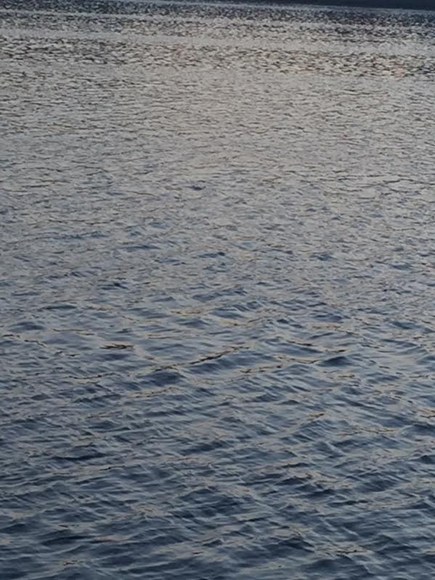
Ahmedabad or Amdavad as spoken and written in Gujarati is not a tourist delight.Yes it is a business Center, a Metropolitan challenging bigger cities like Mumbai or Delhi but still it is a regional City. And it is good that it is a regional city, as it has a character of its own. While Mumbai or Delhi have no identity, the Ahmedabadi or Amdavadi is known for his business acumen. His way of doing business is unique but he is not miser. An Ahmedabadi has a large heart as large as the span of the Sabarmati river on which this City is situated.
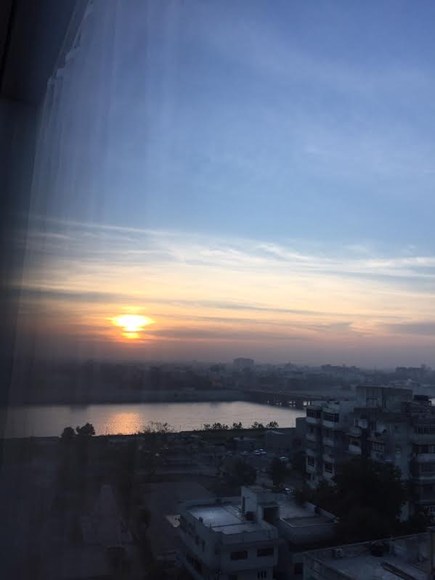
The river Sabarmati which looks gentle as the docile Gujarati is one of the major rivers of the Western India.(This picture is taken from the room of Hyatt Residency where I stayed in December 2015) It originates in the Dhebar Lake in the Aravalli Range of the Rajasthan . It is ungrateful to its birthplace and serves that land for only 9.5 Kms flowing for rest of the 362 kms in Gujarat. It empties out in the Gulf of Cambay or Khambhat.
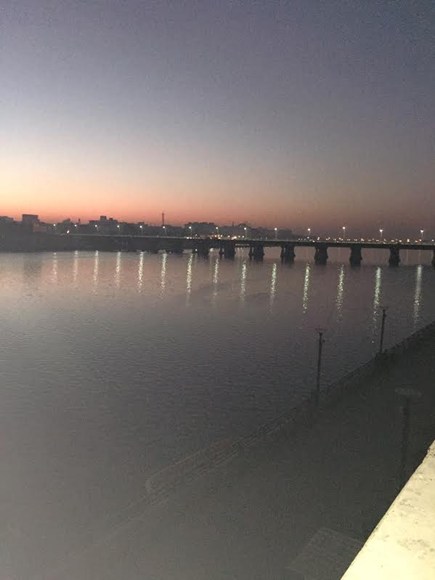
The modern city of Ahmedabad was founded in 1411 along the east Bank of this river Sabarmati. For many years even after Independence, the East side of the city was the heartthrob of the business, with Textile Mills(once more than 100), bullion market, and much more but from 1970s there was slump in the growth of the Textile Mills or rather some of the Owners did not want to update the machinery and gradually the chimneys stopped belching the smoke. Most of the them started closing leaving many unemployed and the City started growing commercially in the West of Ahmedabad. Intially there was only one Bridge called Ellis Bridge Pul but with the expansion of the city on the other side there are more than seven bridges to connect the East and the West.(This picture is of the Sardar Bridge) Similarly the Sabarmati was an important source of water, economic and recreational activities during these years. Though it flowed along both the banks only during the monsoon, it was an important source of economic activity all the year round. The river started polluting due to untreated flow of commercial and domestic sewage and capped by the coming up of slums which added to the ugliness of the banks.
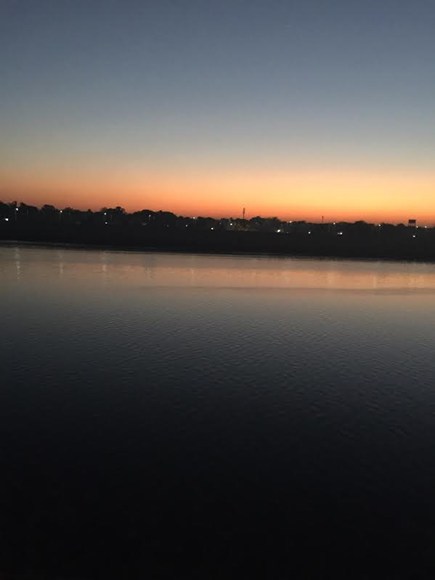
The Sabarmati Riverfront , one of the unique projects on the river flowing through the city was first imagined by a French architect Bernard Kohn who proposed an ecological valley in the Sabarmati basin starting upfront in the Dharoi Dam .Though he later disassociated himself from the Project due to some differences, it was approved to be feasible in 1966 .In 1992 the National River Conservation Plan proposed the construction of sewers and pumping station to reduce the water pollution. It can be said here that Sabarmati was not as dirty as is Yamuna in Delhi or Ganga in Varanasi .In 1997 the Ahmedabad Municipal Corporation was funded by the Govt.of India with a seed capital of Rs.10 million(US$150,000) and thus started the beautification of the riverfront.The construction of the Project in spite of delays and differences started in 2005 and was completed in August 2012 when it was laid open to the public. The 11.5 km long lower promenades are all completed by now and a total of Rs.1152 crore has been spent by now or may be even more. Due to perennial flow of the river, the water table of the city has improved and what was once a sheet of sand is now a gentle stream adding to the beauty of the city besides giving the residents one more point of activity. The ring road built along the river front has opened up certain unopened areas of the city and reduced the distance between the downtown and other parts of the city.
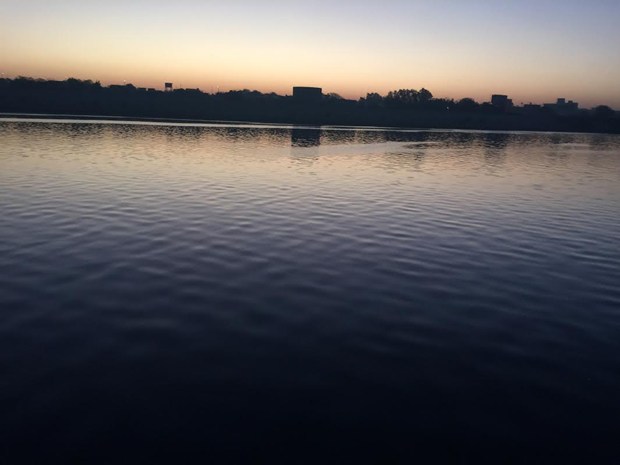
This picture was taken before the Sun rise and shows the East Ahmedabad still sleeping but the early office goers, the school and college students, the auto and taxiwallas and the people who have to catch early flights are already taking advantage of this dormancy.
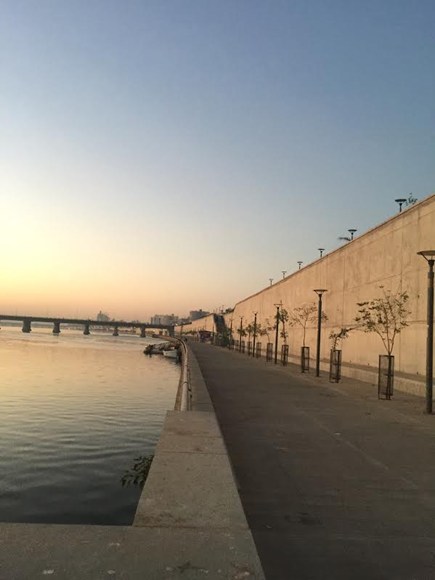
The promenade is one of the ideal place for a morning walk. I utilized my vicinity to the riverfront every morning looking nostalgically over the bridge which we traversed every morning to go to the College.
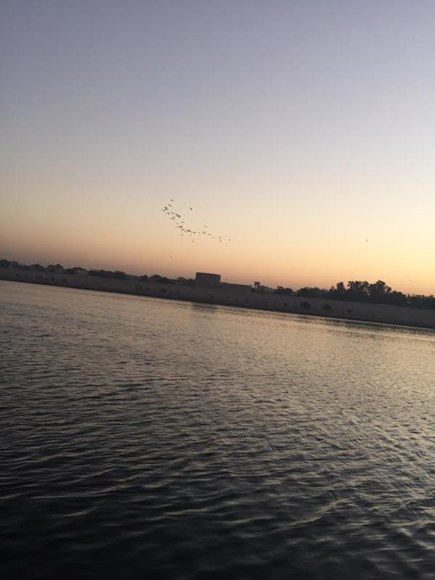
The perennial flow of the river has also generated a revival of the bird life. Once Ahmedabad was know as the City of Trees but now it is a concrete jungle, where Birds have no Trees to lay their nests and eggs. I don't know whether this source of running water will lead to growth of more Trees.
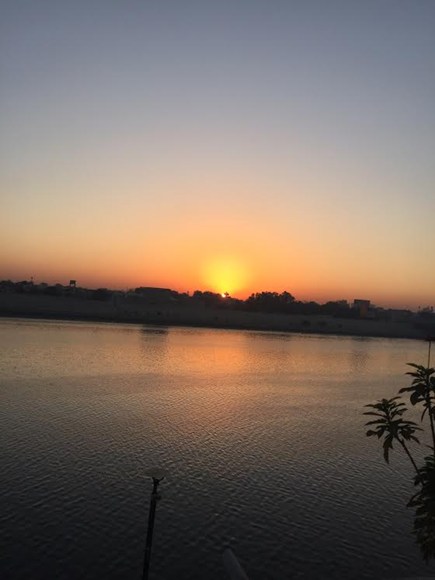
A little ahead, rather upstream of this waterfront, lies the national monument of Sabarmati or Gandhi Ashram . Initially called Kocharab Bungalow, owned by Jivanlal Desai, a barrister friend of Gandhiji, this Ashram was built in its present form on 17 June 2017. This was the residence of Gandhiji and Kasturba and it was from here that the Sabarmati Kay Sant led the famous Dandi March (1930).Just on the opposite side is the Hindu crematorium called Dudheshwar and few kms in the north is the Sabarmati Jail.Perhaps keeping this in mind Gandhiji said "This is the right place for our activities to carry on the search for Truth and develop fearlessness, for one side are the iron bolts of the foreigners and on the other thunderbolts of Mother Nature".
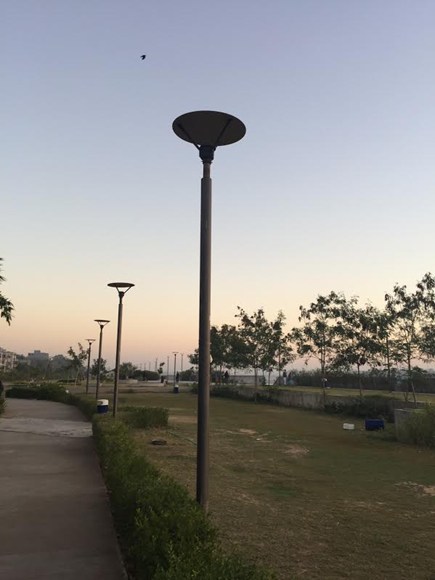
The USP of any Indian Project is lack of upkeep and maintenance. The few brown patches are the early signs of this attitude
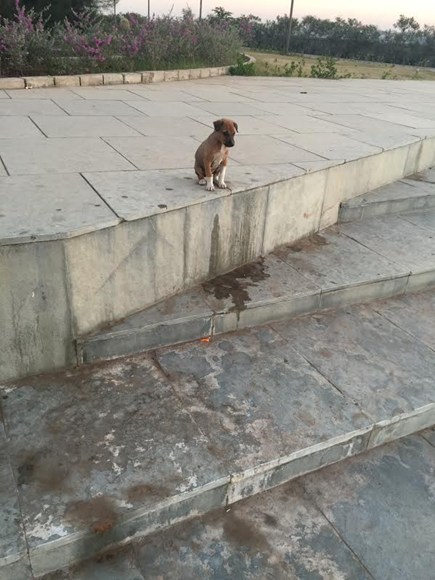
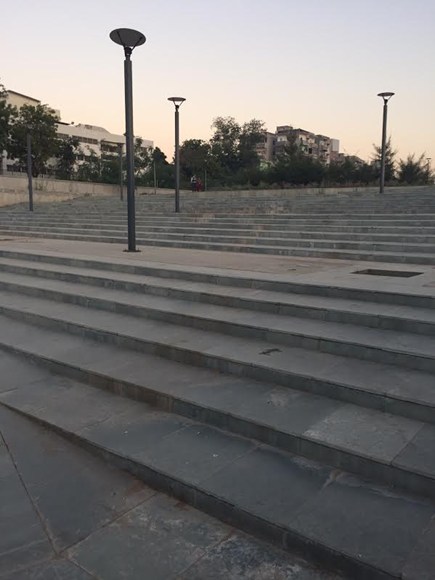
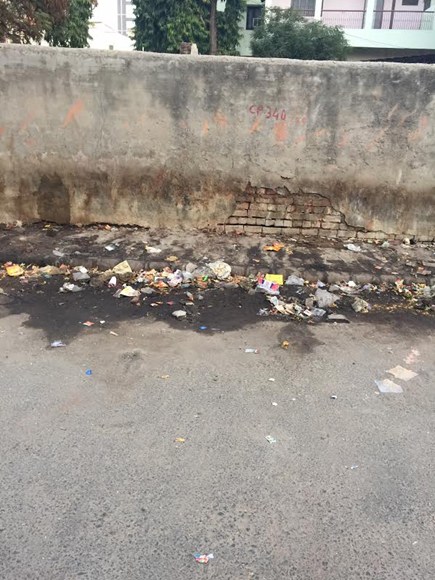
In Gujarati there is a saying "Where ever there is village, there is Trash" And we all sincerely believe in this. If there is something beautiful can ugliness be far behind. Just a few yards from the river front is this ugly site on the Usmanpura side.It needs attention.
(Karor is my Pen Name)
Friday, May 6, 2016
My Delhi Cinema Diary
My Delhi Cinema Diary
When you cross a particular landmark, your thought goes back to the halcyon days when we were young, sprightly and immensely active. During my last visit to Delhi I crossed this landmark theater named after the area where it is located. This was a time when it was an elite place where selected English movies were screened and hence only those people came who could pay little higher rates. Those were different days when the lumpen crowd never entered where they appeared alien. I saw Ruth Prawer Jhabvala's "Heat and Dust" here in 1983.We lived nearer to this auditorium and hence could afford to walk back at night, as autos were unwilling to take short distance passengers.

In 1959, Delite Cinema had an imposing tall building in Central Delhi. It was considered to be the tallest building in Delhi in those years. Whenever I went to Chandni Chowk by Bus, I would see this newest air conditioned theater across the Ram Leela Ground leaving an urge to go and see a movie there. Yes I went to see BEDARD ZAMANA KYA JAANE an Ashok Kumar starer. The Delhi Stock Exchange building came up next door in the 1970s but even in 1959 it was said that the Cinema was built on the most expensive land then.

In Dec.2015 when I was staying in Lajpatnagar, I had a chance to view this Hall from far. Lajpatnagar was an upcoming community in those days of 1959 as Delhi's colonized area did not extend beyond Nowrojji Nagar. We went to see a movie called "HUM HINDUSTANI' and we went by the older form of Metro rail getting down at the Lajpatnagar (Jangpura) station from where it was a walking distance. Sunil Dutt was a hero in this film which had that famous song " Chhoddo Kal ki Baatein, Kal ki Baat Purani" I think it was the first film where Usha Khanna scored the musical.
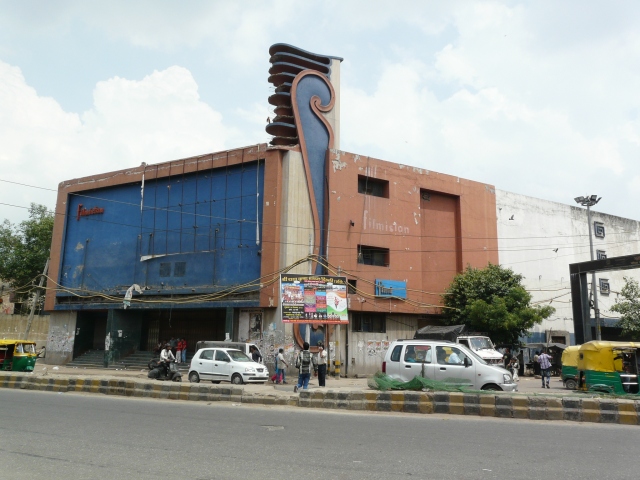
This is Filmistan in Model Basti, Rani Jhansi Road, Karol Bagh now closed and perhaps may turn in to a Cineplex or MacDonald's joint. In the 1966 we had a long stay in Delhi and during that stay we saw the film "GUIDE" which starred the evergreen Dev Anand , Waheeda Rehman and Kishore Sahu. Based on the novel by with a similar name the film was an exceptional success, with some wonderful music by SD Burman. Reading about Kishore Sahu I learnt that during the Divorce proceedings his first wife alleged that Kishore was a "Namard"(Impotent) and hence she was seeking a separation. Kishore Sahu got up and said "My Honor Yes I am Namard" but later when he remarried he had three children from his second wife.One of his son Rohit Sahu faced rape charges registered by his maid. It is also learnt that he wrote a book after his release on this experience. Kishore Sahu was the son of an illustrious family of Chhatisgarh.
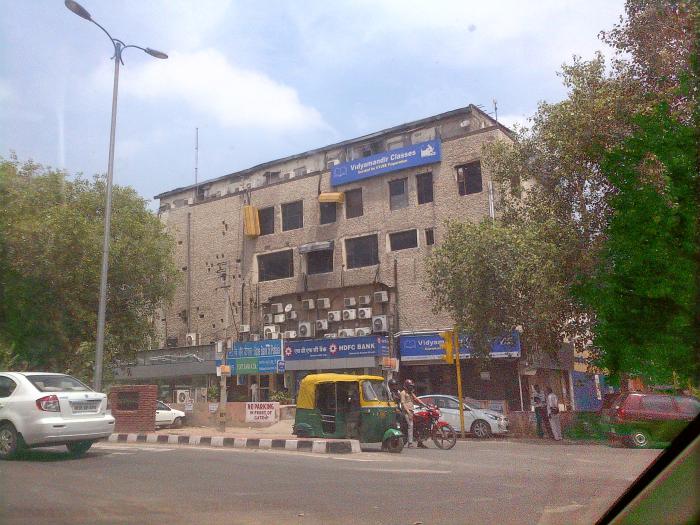
Kamal Theater was built in 1970s in the quieter area of Safdarjung extension. It was a beautiful theater in those days.We were lucky to get a ticket here in the evening show for a movie called "Dastaan" starring thespian Dilip Kumar and Sharmila Tagore. This was a remake of "Afshana" an Ashok Kumar starrer. The Theater has since closed and is now a Mall, a fate which has overtaken most of the single screen Cinema Halls all over the country.

This is the image of the renovated Odeon Cinema now owned by the BIG Cinemas, a Reliance venture. When we went for training at New Delhi in 1966, I saw one of the most discussed movie of those days "The Sound of Music" in this Cinema but in the lower stalls. The Tickets for Balcony and all upper stalls were sold out. A few days later, I went with some friend to see this movie again but still could not get the upper stalls ticket and had to crane our neck to see this wonderful Julie Andrews film. The song "A few of my favorite things" was the most well known song of those days and for many years thereafter. Odeon Cinema was started in 1939 but was closed for many years around 2006 when the single screen theaters faced a battle for survival. Now it is a different genre of the Hall with many unique features.

Regal Theater is a landmark in Delhi, located right in the outer circle of New Delhi and on the link road leading to many North Delhi areas. This was the first theater of Delhi built in 1932 and also the first to screen Cinamascope movies in 1954.(The Robe). Known for its colonial design with a Hotel with same name on the Top whose windows give a panoramic view of the traffic below, the theater now has fallen to bad years screening semi porn movies. In 1959 I saw the well known film here, "Chhoti Bahen" a film whose song "Bhaiya Mori Rakhi kay Bandhan Ko Nibhana"is still heard every year on the Raksha Bandhan Day. Starring Nanda and veteran Rehman, the movie was the most popular those days. One of its other song " Jaon Kahan Batta E Dil, Duniya Badi hai Sangdil " sung by Mukesh is still my favorite song. In 1979 we saw another film "Junoon" in this theater. Made by Shashi Kapoor and Shyam Benegal, this critically acclaimed film was based on the novel of Ruskin Bond "A Flight of Pigeons" It had music scored by Vanraj Bhatia . I recall Vanraj Bhatia saying something like this while receiving an Award a few years ago " Agar Jaldi nahi Maroogay tu Budhay ho Jaogay" (If you don't die early you will become Old).

Kashmere Gate was one of the elite areas of Delhi once . The construction of Connaught Place had taken away much of its importance but for a long time thereafter, Kashmere Gate continued to be the entertainment center for the people living in Civil Lines. One of its entertainment spot was "Ritz" theater built around 82 years ago. Failing to attract people this once popular movie Hall closed its shutters in 2009 but was renovated and reopened in 2012 by the Seth family who own this property. I saw "AASRA" film here in 1966 in the last show without thinking whether we will get conveyance at mid night. Luckily we got the Taxi at reasonable rates. Mala Sinha and Biswajit were the lead players of the film but this Satyen Bose film also had Balraj Sahni and Nirupa Roy playing stellar roles. I still like to hear one of its song "Neend Kabhi Rehti thi Ankhoon Mein Ab Rehtay hain Sawariyan"

This was the Uphaar Theater where the most tragic event of cinema watching took place in June 3, 1997 when the moviegoers were watching the film "Border". 59 people lost their life due to fire and stampede and 109 were left injured, some critically. The theater located in Green Park area of Delhi was rebuilt in 1973 and we saw the film "Aandhi" in 1975. This was the only film I saw with my elder sister while I was in Delhi attending a Course. This Sanjeev Kumar film based presumably on the life of Indira Gandhi was banned after imposition of Emergency but we were lucky to see it before it was banned. The film had some of the most wonderful songs penned by Gulzar.
There may be a few factual errors about time, place, location which may be pardoned. It is always enjoyable to go back into the memory lane. We can only remember the past, can not re live it.
Corporate
Friday, March 4, 2016
The Black Pagoda :Konark
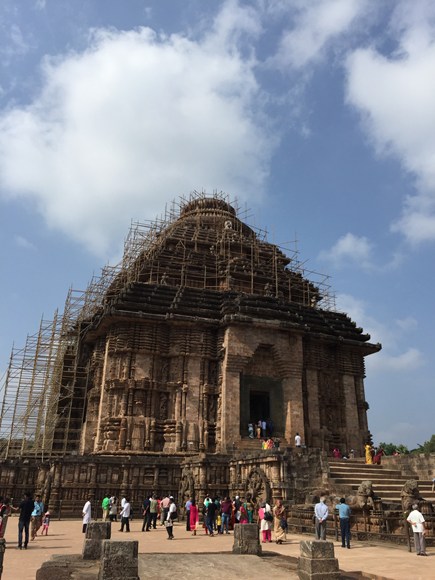
While we value monuments all over the world, we sometimes forget that there are equally good monuments in India too. They are many but the sun Temple of Konark occupies a unique position. Included in the UNESCO World Heritage list since 1984, this 13th century Temple is an eye opener when we reach there. Popularly known as Arkakshetra this temple along with Bhubaneswar and Puri forms a unique triangle on the tourist map of Orissa. Konark means corner of the sun .There are many theories regarding the construction of the temple, but one which appears probable and the most accepted is that it was constructed by Narasimha Deva I, (1238-1264) of the Ganga Dynasty. His Kingdom stretched from Ganga in the north to Godavari in the south and it was during this time that Odisha witnessed the zenith of prosperity. The temple was dedicated to the sun God. A copper plate inscription (verse 86) of Narasimha Deva II dating 1295 AD says that "King Narasimha I built at Kona-Kona a place of great renown, a temple for the Sun to live in with the other Gods".
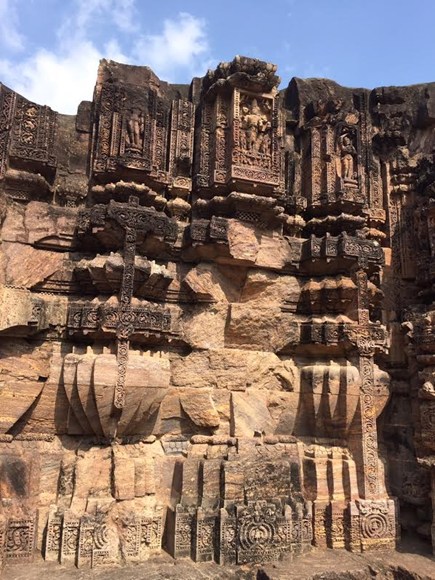
The antiquity of Konark as a famous pilgrimage center for sun workship is mentioned in various Puranas .There is also a story that Samba the son Sri Krishna and Jambavati who had ridiculed Narad had to do his penance at Maitreyavana /Mitravana near the river Chandrabhaga for 12 years to propitiate the Sun God. This Mitravana could be Konark as it is believed, though the Chandrabhaga river today is much smaller river.
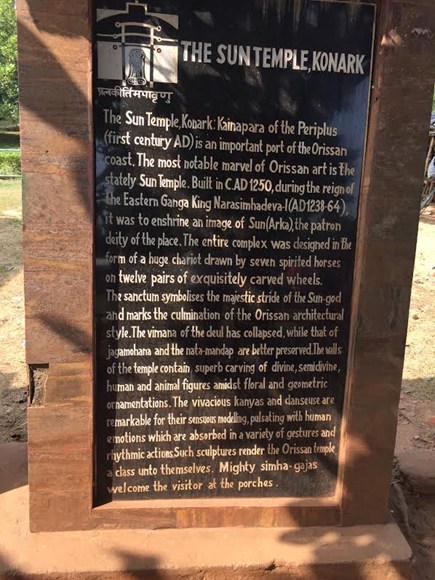
Various theories have been propounded regarding the purpose of selecting this site and erection of such a mammoth Temple or monument at Konark.This place as mentioned above enjoyed religious sanctity from the earliest of times.According to some observation, the mother of Narasimha Deva, suggested him to construct this temple here as this place was one of the few places left which had no big shrine. Sun is believed to be the healer of leprosy and according to some presumptions Narashima Deva constructed this temple as worthy thanks for his healing from this disease. Other theory says that the King got the temple constructed out of a gratitude upon being blessed with a son, whom he ideally named as Bhanudeva(Sun God). Some others say that this was to signal his victory against Tughral Tughan Khan. The Bengal Muslim rulers had made attempts to destroy the Hindu shrines or rob them in this area.His(Narasimha's) victory over Muslim rulers had augmented his resources and status.
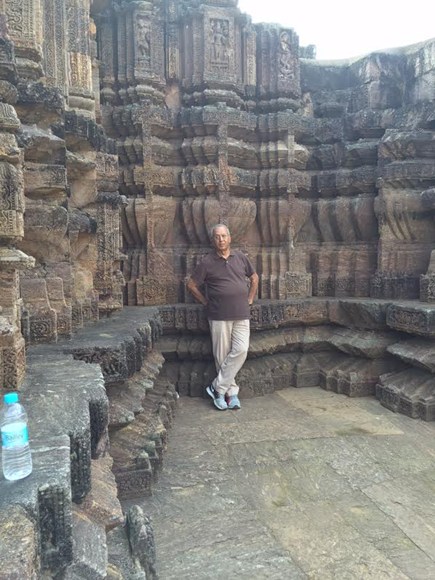
The King appointed Shivai Samantara Mahapatra as Superintendent for the construction of this magnum opus, while the name of Chief Architect (Sutradhar) was Bishu Maharana. It took 12 years,ten months and fourteen days to finish the construction.The image of Surya (Sun) was installed on Sunday the seventh day of Magha Sukla Paksha of 1258 AD.It is believed that 1200 Shilpins(artisans) worked on it non stop and its cost was defrayed by twelve years of revenue of the State.

The original temple had a main sanctum sanctorum (vimana) which was believed to be 229 feet tall. Due to the weight of the superstructure, and weak and sandy soil of the area,vimana fell in 1837. There could be many other factors responsible for the collapse of the Vimana like the effect of a strong gale or earthquake etc. The audience hall (Jagamohana) still stands though it is 128 feet tall and the principal structure among all the ruins.The dance Hall (Nata mandira) and dinning Hall (Bhog Mandapa) are also surviving.
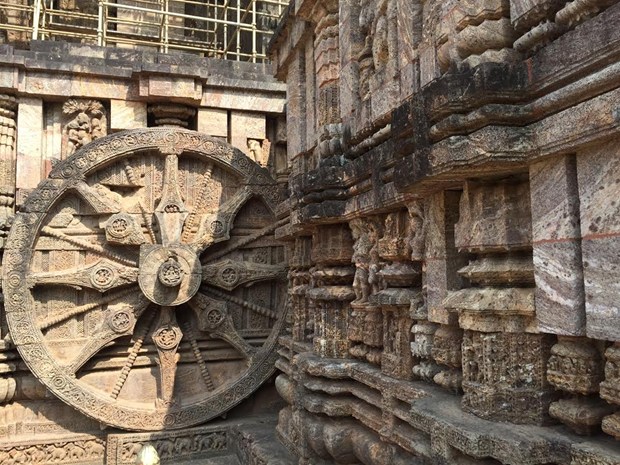
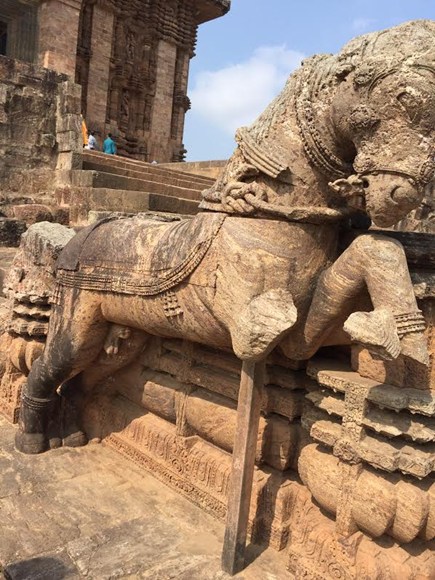
The temple has been built in the form of giant ornamented chariot(Ratha) with 12 pairs of elaborate carved wheels( 3 meters wide)and pulled by 7 horses,4 on the right and 3 on the left.Built in the traditional Kalinga architecture, and Khondalite rocks,it is carefully oriented towards the east so that the first rays of the sun strike the principal entrance of the temple. The wheels of the Temple are sundials which can be used to calculate the time.
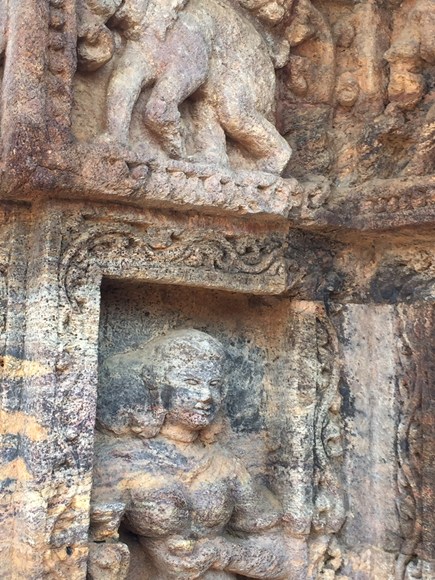
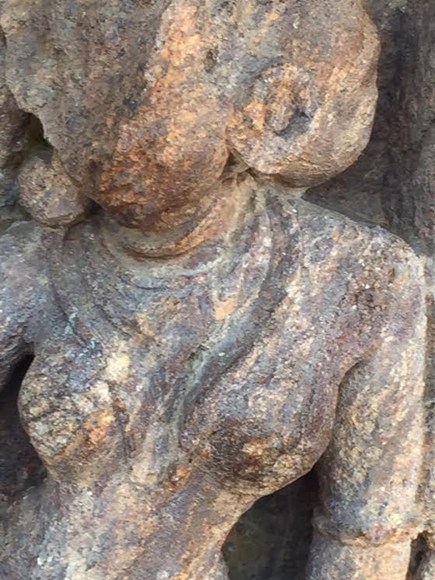

As in all ancient temples, this temple too has intricate art work,precisely chiseled figures and some erotic sculpture. According to an expert, eroticism was not infused as per some plan, but it was the imagery of the artists and the architect of those times. People of that era used to roam about in minimum clothes and partial nakedness was accepted way of life.
Over the centuries the temple has been looted and degraded by Hindu and Muslim rulers, besides the Govt of the day and the people . It is said that Kalasa which was made of copper and the Padmadhavaja (lotus finial) was carried away by the Muslim rulers of Bengal in the course of their attack in 1568 AD.In 1627 the Raja of Khurda removed the sun idol from the temple and moved it to the Jagannath Temple at Puri. Stones and idols were frequently removed by the people affecting the foundation of the monument. Various efforts were also made during the British rule to conserve the Temple including planting of casuarina and punnag trees to act as buffer against the sea wind etc.
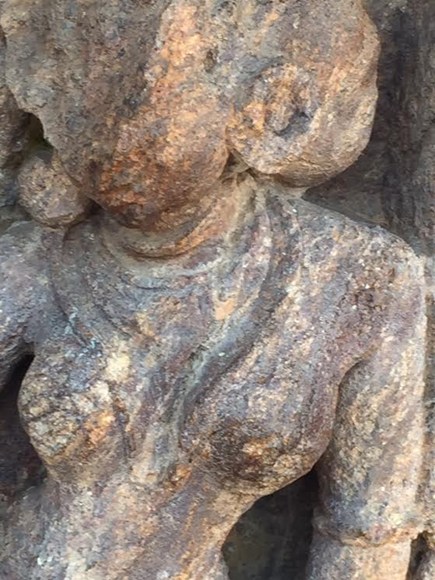
Though the Temple is not in a good shape, though the process of restoration is on, its beauty and charm is immense to attract tourists from all over the world.It is a splendid gem of Odisha and India and its beauty can not be described by a layman like me. When you come back after the visit, you feel you have not seen much and much more is yet to be seen.It has to be revisited for it is a beauty, a joy , and a sacred things with an endless charm.
NOTE: The English called it a Black Pagoda and the Puri Temple was called a white Pagoda. All pictures are mine but the text is partially taken from various historical sources. As per my information, it is not a temple as no worship is carried out there and hence shoes are allowed. There is a story about Dharmapada ,the son of Chief architect Basu Maharana , who leaped to death from the height of the temple to save the honor of his father. I could not get the complete story and hence have not elaborated it.
Subscribe to:
Posts (Atom)




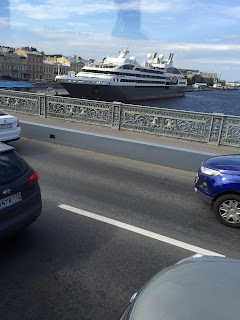









All Comments
0